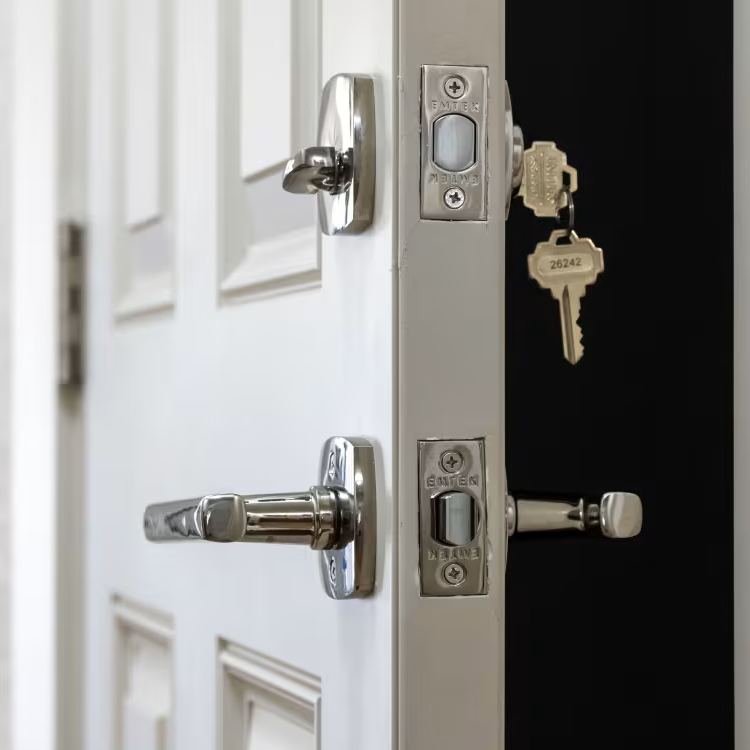Door Hardware Guide
Door Hardware Guide
Table of Contents
- Section #1: Door Handing
- Section #2: Functions
- Section #3: Backset
- Section #4: Types of Door Hinges
- Section #5: Door Hinge Installation
- Section #6: Keying
- Section #7: Mortise Locks
- Section #8: Common Abbreviations & Terms
Section 1: Door Handing
Door Handing (RH, LH, RHR, LHR)
Understanding handing is critical for ordering locks, hinges, operators, or any prep.
Quick Rule (for swing doors): Stand on the "outside" and pull the door toward you.
-
If the hinges are on your right, it’s Right Hand (RH).
-
If the hinges are on your left, it’s Left Hand (LH).
Reverse handing (push side):
-
If it opens away from you and hinges are on the right → Right Hand Reverse (RHR).
-
If hinges are on the left → Left Hand Reverse (LHR).
Most companies follow this rule, but be sure to reference specific companies handing guide for better accuracy.

Section 2: Functions
Passage
-
No locking function.
-
Latch operates by lever or knob from either side.
-
Used for hallways, closets, or rooms that don’t require locking.
Privacy
-
Lockable from the inside with a push-button or turn button.
-
Can be unlocked from outside with an emergency release (e.g., small hole or tool).
-
Used for bedrooms and bathrooms.
Entry (or Entrance)
-
Lockable from the outside with a key.
-
Inside has a thumb turn or lever for locking/unlocking.
-
Used for exterior doors.
Dummy
-
Fixed handle or knob, no latch or locking.
-
Used on doors where only a pull/push handle is needed (e.g., double doors).
Storeroom
-
Locked from outside with a key at all times.
-
Inside lever or knob does not retract latch (no unlocking from inside).
-
Used for storage rooms.
Classroom
-
Locked or unlocked from outside with a key.
-
Inside lever always unlocks and allows free exit.
-
Used for classrooms or offices requiring keyed control.
Exit (or Fire Exit)
-
Free egress with no locking from inside.
-
May have alarm or special hardware.
-
Used for emergency exits.
Occupancy
-
Similar to Privacy but can be locked from outside with a key when occupied (shown with indicators in some cases).
-
Used in commercial restroom or office applications.
Storefront
-
Designed for glass or storefront doors, usually cylindrical locks.
-
Can be keyed and locked from outside.
Hotel/Motel (Privacy Indicator)
-
Locks from inside with privacy button.
-
Outside can be unlocked with a master key or emergency tool.
-
May have an occupancy indicator.
Classroom Security
-
Locks from outside with key.
-
Allows free egress inside.
-
Designed for security-sensitive environments.
Section 3: Backset
Backset is the distance from the edge of the door to the center of the bore hole (usually 2-1/8"). Standard residential backsets in the U.S. are:
-
2-3/8 inches (common for interior doors)
-
2-3/4 inches (common for exterior doors)
Some brands offer adjustable backsets that accommodate both measurements. To measure yours:
-
If no hardware is installed, measure from the door edge to the bore hole center.
-
If hardware is installed, measure to the center of the knob or lever plate.
Note: Incorrect backset = misaligned latch = hardware won’t install properly.
Special sizes like 2", 2-1/2", and 5" backsets are less common and require specific brands (e.g., Schlage or Kwikset).

Section 4: Types of Door Hinges
Butt Hinge (Standard Hinge)
-
Most common hinge for doors.
-
Two rectangular leaves with knuckles, joined by a pin.
-
Comes in square or radius corners.
-
Used for wood, hollow metal, and solid core doors.
-
Common Sizes: 4" x 4" (residential) 4.5" x 4.5" (commercial, 1-3/4" thick doors)
Ball Bearing Hinge
-
A butt hinge with ball bearings in the knuckle.
-
Reduces friction and wear.
-
Used on heavy or frequently used doors (commercial).
Spring Hinge
-
Contains a spring to automatically close the door.
-
Often used on fire-rated or self-closing doors.
-
Adjustable tension.
Continuous Hinge (Piano or Geared Hinge)
-
Runs the full height of the door.
-
Distributes weight evenly.
Pivot Hinge
-
Mounted at the top and bottom of the door, not the side.
-
Great for heavy or wide doors, or for concealed aesthetics.
-
Often used on glass or specialty wood doors.
Concealed (Invisible) Hinge
-
Hidden when door is closed.
-
Provides a clean, modern look.
-
Requires precise mortising and alignment.
Strap Hinge
-
Long decorative arms.
-
Common on gates, barns, or rustic doors.
Olive Knuckle Hinge
-
Decorative, often found in high-end or historic settings.
-
Only the central knuckle is visible.
Double Action (Saloon) Hinge
-
Allows door to swing in both directions and return to center.
-
Used on café/saloon-style doors.
Hospital Tip Hinge
-
A butt hinge with a rounded tip to prevent catching.
-
Used in healthcare settings for safety and hygiene.
Heavy-Duty Hinge
-
Oversized or reinforced hinges for high-load doors or industrial settings.
-
Often include bearings or thrust washers.
Raised Barrel Hinge
-
Used when door trim would obstruct a regular butt hinge.
-
Moves the pivot point outward.
Common hinge radii:
-
Square corner (0") – No curve. Sharp 90° corner. Clean look, but requires chisel or square router bit.
-
1/4" radius – Small curve. Common in commercial doors or where a square corner look is wanted without hand-chiseling.
-
5/8" radius – Large curve. Found on most residential prehung doors. Matches most router templates.
How to tell which you have:
-
Use a ruler or speed square on the corner of the hinge.
-
1/4" radius = about like a nickel.
-
5/8" radius = about like a quarter.
-
Square = flush to ruler with no curve.
Section 5: Door Hinge Installation
Proper Door Hinge Spacing (Standard)
*Please refer to manufacturers guide lines for their specific hinges this is a generalized spacing method
For three hinges on a 7'-0" door (most common setup):
- Top Hinge: 5" down from the top of the door to the top of the hinge
- Bottom Hinge: 10" up from the bottom of the door to the bottom of the hinge
- Middle Hinge: Centered between top and bottom hinges
For Two Hinges (Short Doors):
- Same as three hinges, but skip the center hinge.
For Four Hinges (Tall Doors):
- Top: 5" down
- Bottom: 10" up
- 2nd Hinge: Evenly spaced between top and middle
- 3rd Hinge: Evenly spaced between middle and bottom
Door Height & Number of Hinges Required
- Up to 60" (5'-0") 2 hinges
- 61" – 90" (5'-1" to 7'-6") 3 hinges
- 91" – 120" (7'-7" to 10'-0") 4 hinges
- Over 120" Add 1 hinge for every additional 30"
Add Additional Hinges If:
- Heavy door (solid core, lead-lined, ballistic, etc.)
- High frequency use (schools, hospitals, main entrances)
- Doors with closers or auto operators
- Wide or extra-tall doors
Section 6: Keying
Keying is how locks are set up to be operated by a key (or keys). It’s essential for organizing access and ensuring security in homes, offices, or large buildings.
Keyed vs. Non-Keyed Hardware
- Keyed: Requires a key to operate (entry locks, deadbolts, etc.).
- Non-Keyed: Operated by turn-button, push-button, or always unlocked (passage, privacy, dummy).
Keying Terms
Keyed Alike (KA):
- All locks use the same key.
- Example: Front door + back door = 1 key
Keyed Different (KD):
- Each lock has a unique key.
- Standard for most residential installs
Master Keyed (MK):
- Each lock has its own key plus a master key that opens all.
- Used in offices, hotels, schools
Core Types:
- Standard cylinder: Fixed core, needs disassembly to rekey
- Interchangeable Core (IC): Removable core (like Best, Schlage SFIC/FSIC) — rekeyable without removing the lock
Rekeying vs. Replacing
Rekeying: Changing pins inside the cylinder so a different key works.
- Cheaper than replacing the whole lock
- Replacing: Swapping the entire lock body/cylinder
Section 7: Mortise Locks
A mortise lock is a complete lock system that fits into a pocket (mortise) cut into the door edge. It’s more secure and durable than a cylindrical lock and often used in commercial, institutional, and premium residential settings.
Components:
-
Lock Body: Main mechanism inside the door. Houses latch, deadbolt, and internal cams.
-
Latchbolt: Spring-loaded bolt retracted by handle/lever.
-
Deadbolt: Solid bolt operated by thumbturn or key. Provides extra security.
-
Auxiliary Latch (Deadlatch): Prevents tampering when door is closed.
-
Faceplate: Screwed to door edge. Often 8” x 1-1/4”.
-
Trim: The handles – lever, knob, or pull (inside/outside). Sometimes includes escutcheon or rose plates.
-
Spindles: Connect handle through the lock to retract the latch.
-
Cylinder: Keyed part, inserted through lock body. Often removable core (IC).
-
Strike Plate: Installed on frame, matches latch and bolt locations.
Advantages Of A Mortise Lock
-
Handles heavy use better (office buildings, schools, hospitals).
-
Higher security – latch and deadbolt are integrated.
-
Multiple functions in one lock body.
-
Handles thicker doors, electrified functions, multi-point locking.
Backset & Door Thickness:
-
Standard backset: 2-3/4"
-
Some bodies available in 2-1/2", 2", or even 3-3/4"
-
Door thickness: Standard is 1-3/4", but many mortise locks offer trim kits or special escutcheons for 2-1/4" or thicker
Prep Requirements:
-
Mortise pocket must be precisely cut. Size varies slightly by manufacturer but ~6" tall, 3/4" wide, 3-1/2" deep is typical.
-
Not DIY friendly unless you use a mortise jig or template.
-
Most use through-bolts to mount trim for strength – extra holes required in door face.
-
Strike box in the frame may also need reinforcement or tabs welded on in hollow metal frames.
Cylinders & Cores:
-
Standard mortise locks accept mortise cylinders (threaded)
-
Many brands support interchangeable cores (IC) – small or large format
Trim Styles:
-
Levers (ADA required in most commercial settings)
-
Knobs
-
Thumbturns (for privacy/deadbolt functions)
-
Escutcheon plate (long rectangular plate over lock)
-
Rose trim (small round plate behind handle)
-
Decorative pulls (for dummy trim or entrance doors)
Fire Rating / Code Compliance:
-
Must be UL listed for 20/45/60/90 min fire doors
-
NFPA 80 – requires positive latching
-
ADA – lever height, force, and shape compliance
-
BHMA/ANSI Grade 1 is recommended for commercial use
Section 8: Common Terms & Abbreviations
Cabinet Hardware Guide
Coming Soon...
Bathroom Guide
Coming Soon...
Kitchen Guide
Coming Soon...

